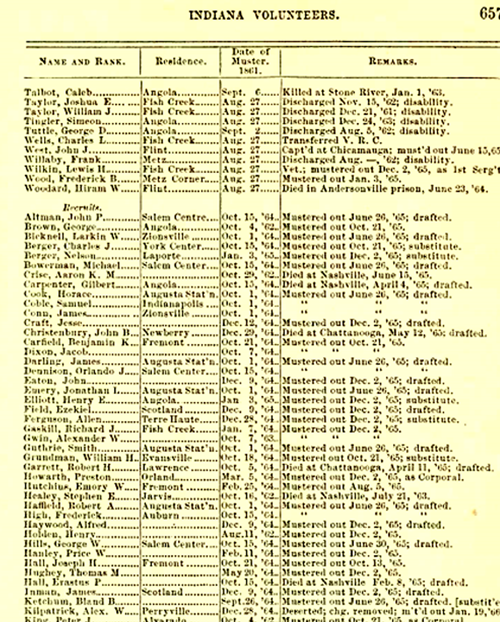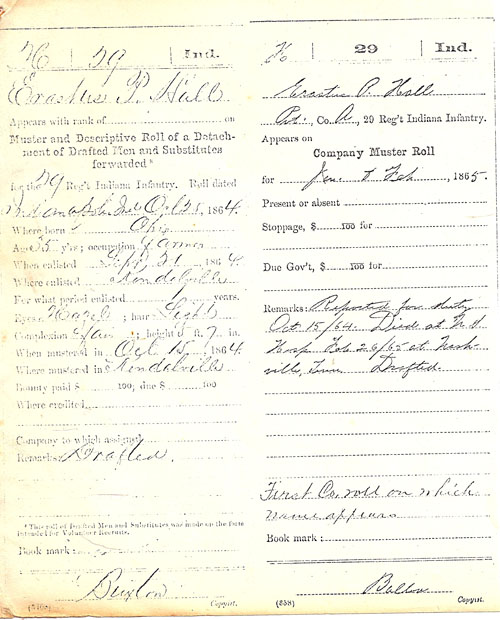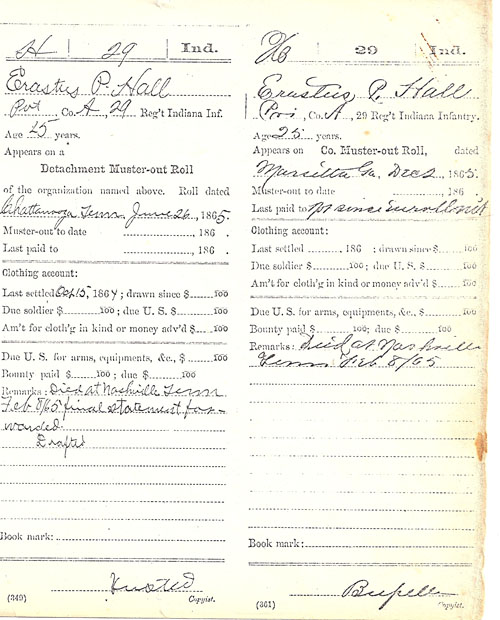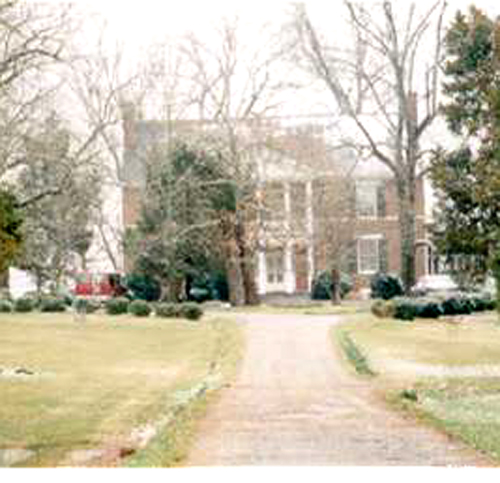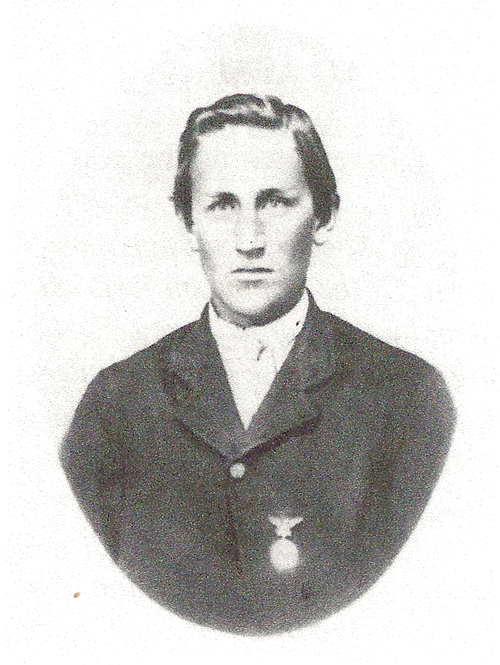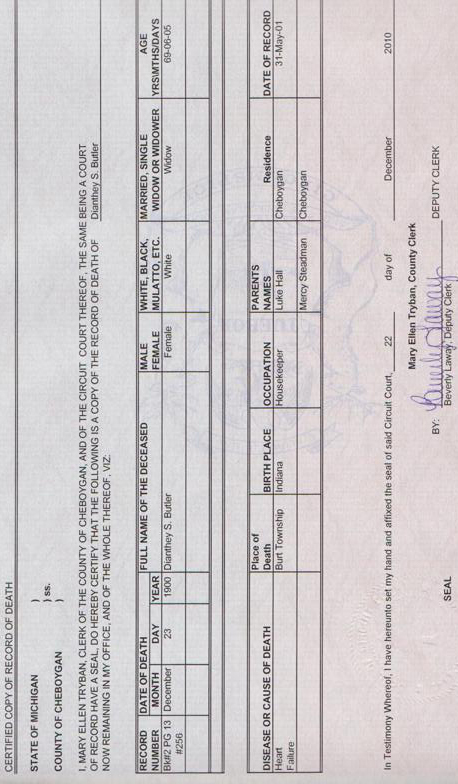Generations 4-6
By Kathryn Hall | February 8, 2014
Fourth generation Samuel [4] Hall (Samuel [3] Samuel [2] George [1]) Born 2 Dec 1710, Suffield, Hartford Co., CT. Married Hannah Parsons 1 October 1741. Hannah died 14 May 1803 “in her 84th year” and is buried in North Cemetery, Somers, Tolland Co., CT. 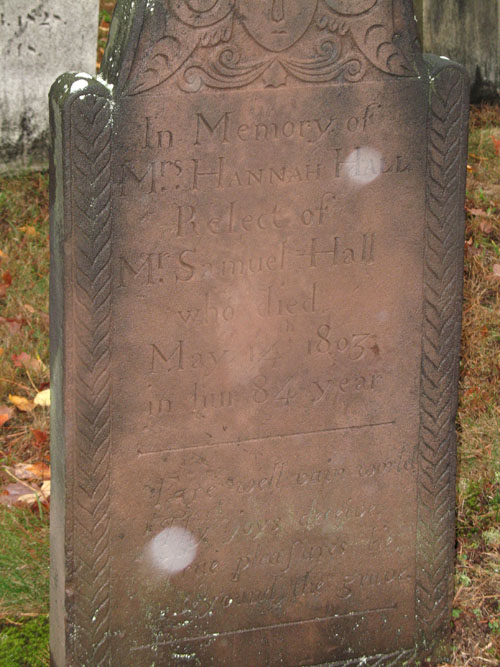 Children: i. Luke [5] Hall (Samuel [4] Samuel [3] Samuel [2] George [1]) Luke Hall married Elizabeth Cooley (1). Elizabeth died 2 February 17–(age 24). She is buried in North Cemetery, Somers, Tolland Co., CT.
Children: i. Luke [5] Hall (Samuel [4] Samuel [3] Samuel [2] George [1]) Luke Hall married Elizabeth Cooley (1). Elizabeth died 2 February 17–(age 24). She is buried in North Cemetery, Somers, Tolland Co., CT. 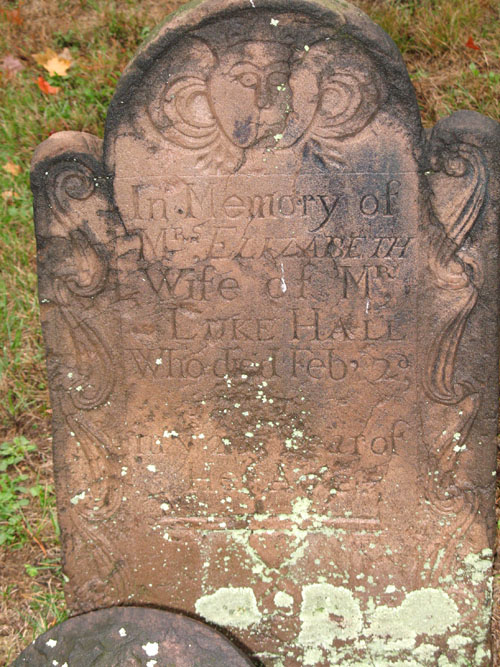 Luke married Martha Davis (2). Martha died 31 January 1821, age 66. She is buried in North Cemetery, Somers, Tolland Co., CT.
Luke married Martha Davis (2). Martha died 31 January 1821, age 66. She is buried in North Cemetery, Somers, Tolland Co., CT. 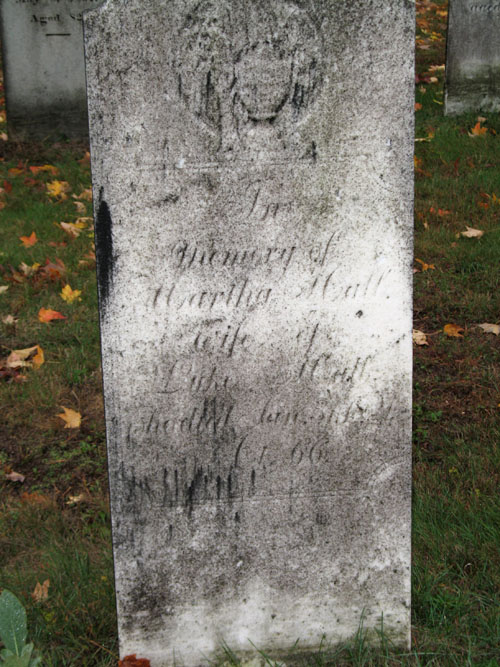 Luke died 19 September 1826 (age 82). Children: i. John Died 14 November 1814 (age 16). He is buried in North Cemetery, Somers, Tolland Co., CT. ii. Hannah Died 29 November 1814 (age 19). She is buried in North Cemetery, Somers, Tolland Co., CT iii. Luke [6] Born 20 May 1773 in Somers, Tolland Co., CT. Died after September 1843 in Smyrna, Chenango Co., NY. Married Ruby Pease on 8 January 1795 in Somers, Tolland Co., CT. Ruby born 30 December 1776 in Somers, Tolland Co., CT. Ruby died after 1850 in Smyrna, Chenango Co., NY. Children: i. Luke [7] Born 6 July 1795 in Somers, Tolland Co., CT. Married Mercy Stedman (1). Married Bridget McLaughlin (2) in 1868. Luke died in MI. Note: The marriage of Luke Hall, widower, age 73, and Bridget McLaughlin, widow, age 49, was recorded on 29 September 1868 in Isabella Co., Michigan. The marriage was performed 27 September 1868 in Lincoln, Michigan, by William R. Robbins, Justice of the Peace. W. S. Fowler of Coe and Phoebe Fowler of Lincoln were witnesses. Luke was a farmer, living in Coe, Isabella County, Michigan and was born in Somers,Connecticut. Bridget was living in Lincoln, Isabella Co., Michigan, and was born in Kings County, Ireland. ii. Ruby Born 14 July 1797 in Somers, Tolland Co., CT. iii. Daniel Spencer Born in 1808 in Smyrna, Chenango Co., NY iv. Fanny Born December 1803 v. Flora Born 11 February 1805 vi. Erastus Gilbert Born 20 May 1813 in Smyrna, Chenango Co., NY. Died in 1893. Married Mehitable “Hitty” Orinda Tobey, born 1818. vii. Hesekiah Cooley Born 9 May 1810; died 1872 in NJ. viii. Dolly Hall Born 5 April 1816 [Notes: Loren and Lyman Hall died in their childhood. Records taken from West Hill Church. KH]
Luke died 19 September 1826 (age 82). Children: i. John Died 14 November 1814 (age 16). He is buried in North Cemetery, Somers, Tolland Co., CT. ii. Hannah Died 29 November 1814 (age 19). She is buried in North Cemetery, Somers, Tolland Co., CT iii. Luke [6] Born 20 May 1773 in Somers, Tolland Co., CT. Died after September 1843 in Smyrna, Chenango Co., NY. Married Ruby Pease on 8 January 1795 in Somers, Tolland Co., CT. Ruby born 30 December 1776 in Somers, Tolland Co., CT. Ruby died after 1850 in Smyrna, Chenango Co., NY. Children: i. Luke [7] Born 6 July 1795 in Somers, Tolland Co., CT. Married Mercy Stedman (1). Married Bridget McLaughlin (2) in 1868. Luke died in MI. Note: The marriage of Luke Hall, widower, age 73, and Bridget McLaughlin, widow, age 49, was recorded on 29 September 1868 in Isabella Co., Michigan. The marriage was performed 27 September 1868 in Lincoln, Michigan, by William R. Robbins, Justice of the Peace. W. S. Fowler of Coe and Phoebe Fowler of Lincoln were witnesses. Luke was a farmer, living in Coe, Isabella County, Michigan and was born in Somers,Connecticut. Bridget was living in Lincoln, Isabella Co., Michigan, and was born in Kings County, Ireland. ii. Ruby Born 14 July 1797 in Somers, Tolland Co., CT. iii. Daniel Spencer Born in 1808 in Smyrna, Chenango Co., NY iv. Fanny Born December 1803 v. Flora Born 11 February 1805 vi. Erastus Gilbert Born 20 May 1813 in Smyrna, Chenango Co., NY. Died in 1893. Married Mehitable “Hitty” Orinda Tobey, born 1818. vii. Hesekiah Cooley Born 9 May 1810; died 1872 in NJ. viii. Dolly Hall Born 5 April 1816 [Notes: Loren and Lyman Hall died in their childhood. Records taken from West Hill Church. KH]
Topics: Connecticut | No Comments »
Registration of Nelson Wesley Hall with Sons of Union Veterans of the Civil War
By Kathryn Hall | September 25, 2013
This week I have received verification that Nelson Wesley Hall has been registered with the Sons of Union Veterans of the Civil War.
Hello, Ms. Hall,
We do have Nelson Wesley Hall, 5th Indiana Light Artillery now registered, buried at Bagley Cemetery, Otsego County, Michigan. You can see his record by going to http://www.suvcwmi.org/ then National Graves Registration Database, then Search Entries, then type in Nelson’s name, 5th Indiana Light Artillery.
Rick Danes
Topics: Civil War | No Comments »
George Hall of Taunton: Halls of New England excerpt
By Kathryn Hall | June 11, 2013
The following is an excerpt from The Halls of New England compiled by David Brainard Hall and published in 1883.
THE HALLS OF TAUNTON, MASS.
George Hall and his wife Mary [Family i), were the ancestors of the Halls of Taunton. They emigrated, it is said, from Devonshire County, England, in 1636-7. George Hall is recorded as proprietor of land in Duxbury, Mass., in 1637, about the date of his settlement in ” Cohannet,” — Taunton ; he was one of the forty-six original proprietors of the first territorial ” purchase ” of the Indian Sachem Massasoit, including a tract of eight miles, (an oblong, square, being the present territory of Taunton, Berkley, Raynham, extending to Mansfield) ; he had a twelve acre share, in connection with Richard Williams, John and Walter Dean and others, who had similar shares, spanning Taunton river, on the banks of which they erected their first humble dwellings and were neighbors and friends for lifetime. The selection of their homesteads included the most eligible land of the purchase, on what is now Dean street ; the land skirting the banks of the river had been cultivated by the Indians for years ; and these homesteads have been successively transmitted from ancestors to descendants nearly two hundred years, of whom the sixth, seventh and eighth generations are now owners and residents.
George Hall was one of the founders of the town of Taunton in 1639, was propounded as a freeman in 1643, enrolled to bear arms that year ; admitted as a freeman in 1645, and was constable of the town the same year ; he was a member of the board of the supervising council, of which William Pole was chairman, in 1657, and was chairman of the board of selectmen (established by the colonial court in 1662), from 1666 to 1669, the time of his decease; he was one of the founders of the Pilgrim Congregational church and society of Taunton, and contributed liberally to its support ; also one of the stock proprietors of the first iron ” bloomery ” established in this region by the Leonards and other citizens of Taunton, upon the site of the present “old forge ” how in Raynham; he was its first clerk in 1656, continuing several years in that capacity, and was succeeded after his death bv his son John. In October, 1669, he was taken seriously ill ; he called his friends, Deacons Richard Williams and Walter Dean, and made his will on the i6th, witnessed by them, and died on the 30th of that month, aged about 69 years ; his widow Mary was appointed executrix ; the will was probated in March, 1670. After his death, his widow and sons John, Joseph and Samuel were shareholders in the iron works ; these works have been continued until recently, over two hundred years. Soon after they were started, bar iron manufactured there from native ore dug in the vicinity, was made a “circulating medium ” in business transactions and on account of the scarcity of specie ; orders to that effect drawn by Rev. Samuel Danforth, the fourth minister of Taunton, for a portion of his salary, a few years later, and by others for business purposes, are now in careful preservation.
George Hall was one of the largest landholders in Taunton, and divided it among his sons. They were also among the proprietors of the large tract, called ” Taunton North Purchase,” which included the territory of the present towns of Norton, Easton and portions of Mansfield and Raynham, upon which, many of their descendants settled as farmers and business men ; more than a thousand descendants now bear the ancestral name. The children mentioned in the will of George Hall were :
I. John, b. in 1640 (Family 2). 2. Joseph, b. in 1642 (Family
3). 3. Samuel, b. in 1644 (Family 4). 4. Charity. 5. Sarah.
6. MaryThe town records were burned in 1838, hence the loss of many valuable clues.
Topics: Massachusetts | No Comments »
Halls in the Civil War: Erastus P. Hall
By Kathryn Hall | June 2, 2013
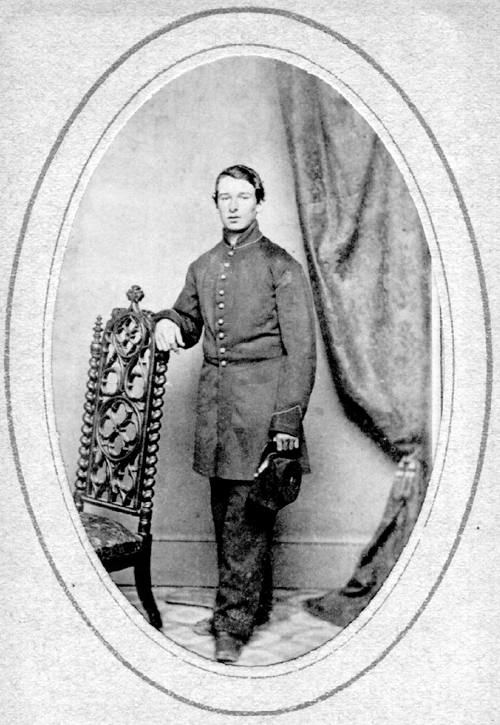
Erastus P. Hall (d. 8 February 1865)
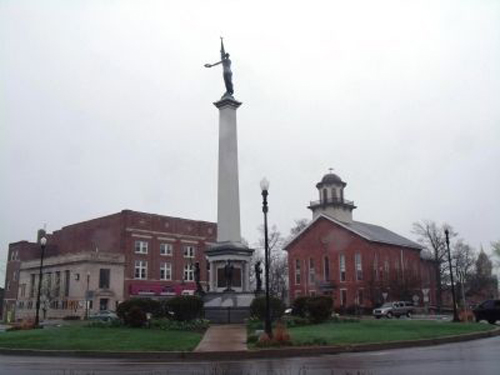
Steuben County Soldiers Monument
Erastus P. Hall is listed on the Steuben County Soldiers Monument as having served in the 29th Indiana Infantry, and died in service. Erastus P. Hall is also listed as a member of the 29th Regiment, Company A in History of Starke County, IN, Vol. 1, 1915, Chapter XVI, The County’s Soldiers, pp.135-137.
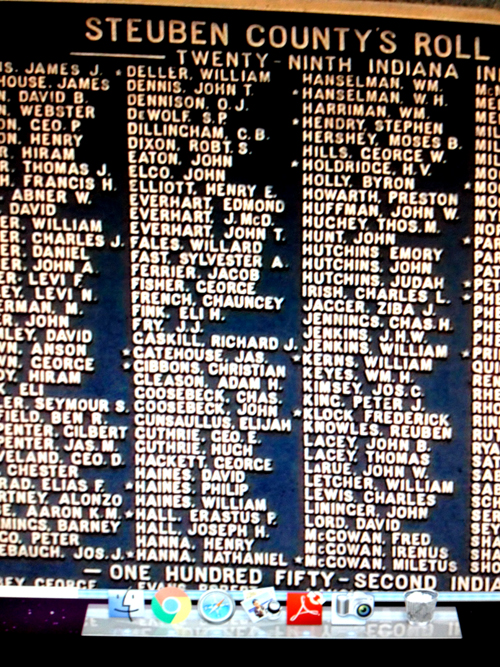
Record Series: Military Records
Collection: Civil War
County: StatewideReferencenumber: CIV076626
Accession Number: 1938001
Party: Name
Age: 25
Date Enrolled: 1864/09/21
Where Enrolled: Kendallville, Indiana
Regiment: 29
Company: A
Discharge Date: 1865/02/08
Notes: Died at Nashville, TN. (Hale)
Cavalry/ Battery Unit:
Name: Erastus P. Hall
Party Type: Name
Source: http://www.indianadigitalarchives.org/ViewRecord.aspx?RID=FB35622D12B4C9567E840B700EBEF0D9
Above we find Erastus Hall listed near end of this list of Indiana soldiers. He is drafted 15 October 1864. By the time Erastus is drafted his battalion has already fought the Battle of Shiloh, Battle of Stones River and the Battle of Chickamauga, and the war is winding down. This record lists his death in Nashville as 8 February 1865.
Good morning, Ms. Hall.
Thank you for allowing us to honor your ancestor by placing his final resting place in our National Graves Database for all to use as a resource. I have found Erastus in the 1850 and 1860 De Kalb County, IN Census, and buried as E. P. Hall at Nashville National Cemetery, Section H, Grave # 9371. He has a military headstone, and the Official Record states his death date as 8 February, 1865 in Nashville.
Rick Danes
Graves Registration Officer
Department of Michigan
and Member, National Graves Registration Committee
Sons of Union Veterans of the Civil War
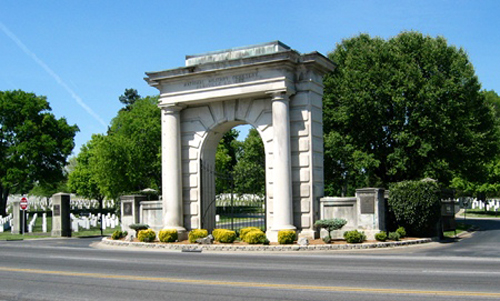
Nashville National Cemetery, Madison,Tennessee
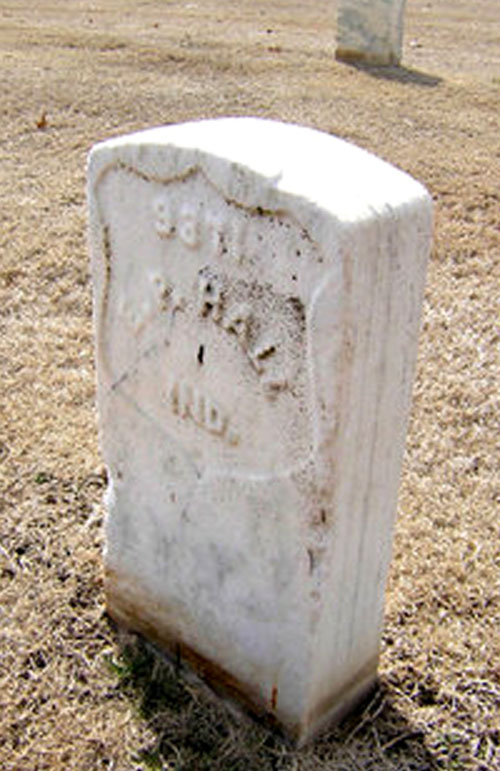
Gravestone of Erastus P. Hall, Nashville National Cemetery, Madison, Tennessee
This is a photo of Hord House, which served as a Union field hospital in Nashville, Tennessee. This is one of the many hospitals in Nashville during the Civil War. Was this the hospital where Erastus P. Hall died on 8 February, 1865? He would have been interred on the grounds of Hord House after his death. In whichever of Nashville’s hospitals he died, when the Nashville National Cemetery was established he was reinterred there. That we know for certain.
[Editor’s note: we have now learned that Erastus died at one of the many General Hospitals in Nashville, according to his widow’s pension request. I will continue to try to refine that search and ID the exact hospital. KH]
“Most of the land for Nashville National Cemetery was acquired shortly after the Civil War. In July 1866, 45 acres were transferred to the United States from Morton B. Howell, master of the Chancery Court of Nashville, in accordance with the decree of the court. During the first few months of 1867, another 17 acres were conveyed in the same manner. The final portion, about 1-1/2 acres, was purchased by the United States in 1879 from J. Watts Judson.
The original interments were the remains of soldiers removed from temporary burial grounds around Nashville’s general hospitals, as well as the Civil War battlefields at Franklin and Gallatin, Tenn., and Bowling Green and Cave City, Ky. There are 4,141 unknowns interred at Nashville National Cemetery.
The stone wall around the cemetery and the limestone archway at the entrance were both constructed in 1870.”
Notes on Hord House are drawn from Stones River National Battlefield Historic Resource Center (2004) by Sean Styles:
Hord House
This home, also known as Elmwood, is located on the Nashville Pike. It was constructed in 1842 using bricks produced by slaves owned by Thomas Hord, who supervised the building of this house. This structure is an I-house with end wall chimneys; a two-story pedimented portico occupies the middle bay of the three-bay facade. Some historic wooden farm outbuildings also remain. The house and other structures on the farm are included in the National Register of Historic Places (NR Identification 73001823).At the time of the battle, Thomas and Mildred Amelia Gilmer Hord lived at Elmwood. Although his oldest son joined the Confederate army, Thomas Hord held unionist sentiments. During the Battle of Stones River, Union forces used the Hord House as a hospital. The Hord family was actually in residence at the time of the battle, and Thomas Hord related that “the house was unexpectedly and suddenly taken for a hospital and the wounded brought in so rapidly that there was not time or means of removing the carpets or furniture.” Amelia Hord
assisted in caring for the wounded despite her advanced pregnancy.
Here are some more facts about Union hospitals in Nashville during the Civil War:
The Union military hospital network on Nashville accounted for 10-15% of the Union’s total military hospital capacity, serving approximately 100,000 soldiers during the Civil War. At the worst of times over 14,000 men were being cared for at a time. The Union Nashville hospital network had the third largest medical school in the US, and by standards of the day, Nashville’s system was first rate. The death rate among patients was 8-10%. This hospital network in Nashville was located along major water and rail lines. Harper’s Weekly published these images in their February 1864 issue, which expands our understanding of what it took to get wounded and dying soldiers off the battlefields into care.
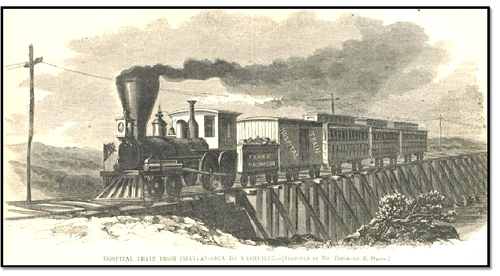
hospital train taking soldiers from Chattanooga to Nashville Union hospital network
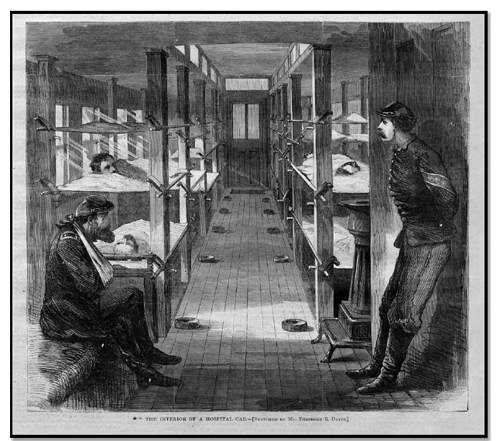
inside the Union hospital train
29th Regiment Indiana Infantry
Organized at LaPorte, Ind., and mustered in August 27, 1861. Ordered to Kentucky and joined General Rousseau at Camp Nevin October 9, 1861. Attached to Wood’s Brigade, McCook’s Command at Nolin, Ky., to November, 1861. 5th Brigade, Army of the Ohio, to December, 1861. 5th Brigade, 2nd Division, Army of the Ohio, to September, 1862. 5th Brigade, 2nd Division, 1st Corps, Army of the Ohio, to November, 1862. 2nd Brigade, 2nd Division, Right Wing 14th Army Corps, Army of the Cumberland, to January, 1863. 2nd Brigade, 2nd Division, 20th Army Corps, Army of the Cumberland, to October, 1863. 1st Brigade, 1st Division, 4th Army Corps, Army of the Cumberland, to April, 1864. 1st Separate Brigade, Garrison at Chattanooga, Tenn., Dept. of the Cumberland, to January, 1865. 2nd Brigade, 1st Separate Division, District of the Etowah, Dept. of the Cumberland, to May, 1865. 2nd Brigade, 2nd Separate Division, District of the Etowah, Dept. of the Cumberland, and Dept. of Georgia, to December, 1865.
SERVICE.– Camp at Nolin River, Ky., till December, 1861, and at Munfordsville, Ky., till February, 1862. March to Bowling Green, Ky., thence to Nashville, Tenn., February 14-March 3, and to Savannah, Tenn., March 16-April 6. Battle of Shiloh, Tenn., April 6-7. Advance on and siege of Corinth, Miss., April 29-May 30. Near Corinth May 9. Pursuit to Booneville May 31-June 6. Buell’s Campaign in Northern Alabama and Middle Tennessee June to August. Gallatin August 13. March to Louisville, Ky., in pursuit of Bragg, August 21-September 26. Pursuit of Bragg into Kentucky October 1-15. Near Clay Village October 4. Dog Walk October 9. March to Nashville, Tenn., October 16-November 7. Reconnoissance to Lavergne November 26-27. Lavergne, Scrougesville November 27. Duty at Nashville till December 26. Advance on Murfreesboro December 26-30. Battle of Stone’s River December 30-31, 1862, and January 1-3, 1863. Duty at Murfreesboro till June. Action at Triune June 11. Middle Tennessee or Tullahoma Campaign June 23-July 7. Liberty Gap June 24-27. Occupation of Middle Tennessee till August 16. Passage of Cumberland Mountains and Tennessee River and Chickamauga (Ga.) Campaign August 16-September 22. Battle of Chickamauga September 19-20. Reopening Tennessee River October 26-29. Duty at Bridgeport, Ala., till January, 1864. Garrison duty at Chattanooga till May, 1865. Action at Dalton, Ga., August 14-15, 1864. Garrison duty at Marietta and Dalton, Ga., till December. Mustered out December 2, 1865.
Regiment lost during service 4 Officers and 56 Enlisted men killed and mortally wounded and and 4 Officers and 240 Enlisted men by disease. Total 304.
Source: A Compendium of the War of the Rebellion by Frederick H. Dyer. Copyright, 1908.
Name: E P Hall
Service Info.: PRIVATE US Army
Death Date: 8 Feb 1865
Interment Date: 8 Feb 1865
Cemetery: Nashville National Cemetery
Cemetery Address: 1420 Gallatin Road, South Madison , TN 37115
Buried At: Section H Site 9371
Editor’s notes: Throughout the years it has been speculated that Erastus P. Hall’s middle name was either Pease or Perry. It is my belief that neither of these is correct. It is my belief that his middle name was Plimpton, and that his parents, Luke Hall and Mercy Steadman Hall, named him after Reverend Billings O. Plimpton of the Methodist Church, as they were founding pioneers of Plimpton’s congregation. See notes on Erie Conference. The fact that Luke and Mercy Hall named their older son Nelson Wesley Hall, a clear nod to Methodist founder John Wesley, only adds to the speculation. It is also noteworthy that the leaders of their Methodist congregation were fierce abolitionists, adding to a motive for Erastus and his brother to join the Union army, especially given the pioneering role his parents played in the founding of the church. KH
Topics: Civil War | No Comments »
Halls in the Civil War: Nelson Wesley Hall
By Kathryn Hall | May 26, 2013
Nelson Wesley Hall (b. 3 March 1835–d. 28 September 1903)
The photograph above is most likely of Nelson Wesley Hall. As the picture, found in family records, was not properly ID’d, there was some question as to whether this photo was of Nelson or his younger brothers Lafayette or Erastus. We must assume it is, in fact, of Nelson, as he is wearing the medal on civilian clothing, and, more importantly, medals were distributed after the war. Nelson’s brother Erastus did not return from the war. [See subsequent post.] Add to this that the picture was found among the belongings of direct descendants of Nelson. However, the identification of this photo was done only after consulting with a Civil War historian, with the Indiana Historical Society and with noted Civil War novelist Jeff Shaara, who writes:
Dear Ms. Hall,
My best guess is that, since he’s actually wearing a medal, he survived the war by a while. Medals were not at all common during the war- most of them having been awarded afterward. So yes, I agree with your logic.
Thank you for asking!
Jeff Shaara
[Footnote: Since posting this a researcher kindly provided me with a photograph of Erastus Hall. See his Civil War post to view. KH]
Nelson W. Hall – Civil War
Record Series: Military Records
Collection: Civil War
County: StatewideReferencenumber: CIV076877
Accession Number: 1938001
Party: Name
Age: 26
Date Enrolled: 1861/10/08
Where Enrolled: Indianapolis, Indiana
Regiment:
Company:
Discharge Date: 1864/11/24
Notes:
Cavalry/ Battery Unit: 5th Light Artillery
Name: Nelson W. Hall
Party Type: Name
Source: http://www.indianadigitalarchives.org/ViewRecord.aspx?RID=01086E0350E23015A7C203541CFEE1BE
Nelson Wesley Hall was part of the Indiana Light Artillery, 5th Battery which was under the leadership of Capt. Peter Simonson. Indeed, this artillery unit was originally referred to as Capt. Simonson’s Battery. The name was later changed. On June 15th, 1864 Captain Simonson ordered the artillery shot that killed Confederate General Leonidas Polk. Simonson himself was killed the next day by a rebel sharp shooter at Pine Mountain, Georgia.
Service: Duty at Camp Gilbert, Louisville, Ky., till December 20, 1861, and at Bacon Creek, Ky., till February, 1862. Advance on Bowling Green, Ky., Nashville, Tenn., February 10-25. Occupation of Bowling Green, Ky., February 15, and of Nashville February 25. Moved to Murfreesboro, Tenn., March 18. Reconnoissance to Shelbyville, Tullahoma and McMinnville March 25-28. Advance on Fayettesville and Huntsville, Ala., April 7-11. Capture of Huntsville April 11. Advance on and capture of Decatur April 11-14. Duty at Bridgeport, Ala. (Detachment), and along Nashville & Chattanooga R. R. till August. Moved to Stevenson, Ala., August 24. Moved to Nashville, Tenn.; thence to Louisville, Ky., in pursuit of Bragg, August 31-September 26. Pursuit of Bragg into Kentucky October 1-15. Battle of Perryville, Ky., October 8. March to Nashville, Tenn., October 20-November 9, and duty there till December 26. Advance on Murfreesboro, Tenn., December 26-30. Battle of Stone’s River December 30-31, 1862, and January 1-3, 1863. Duty at Murfreesboro till June. Middle Tennessee (or Tullahoma) Campaign June 22-July 7. Liberty Gap June 22-24. Occupation of Middle Tennessee till August 16. Passage of the Cumberland Mountains and Tennessee River and Chickamauga (Ga.) Campaign August 16-September 22. Battle of Chickamauga September 19-20. Siege of Chattanooga, Tenn., September 24-October 26. Reopening Tennessee River October 26-29. Outpost duty at Shellmound till February, 1864. Demonstrations on Dalton February 22-27. Tunnel Hill, Buzzard’s Roost Gap and Rocky Faced Ridge February 23-25. Stone Church, near Catoosa Platform, February 27. Atlanta (Ga.) Campaign May 1 to September 8. Tunnel Hill May 6-7. Demonstration on Rocky Faced Ridge Dalton May 8-13. Buzzard’s Roost Gap May 8-9. Near Dalton May 13. Battle of Resaca May 14-15. Near Kingston May 18-19. Near Cassville May 19. Advance on Dallas May 22-25. Operations on line of Pumpkin Vine Creek and battles about Dallas, New Hope Church and Allatoona Hills May 25-June 5. Operations about Marietta and against Kenesaw Mountain June 10-July 2. Pine Hill June 11-14. Lost Mountain June 15-17. Assault on Kenesaw June 27. Ruff’s Station July 4. Chattahoochie River July 5-17. Peach Tree Creek July 19-20. Siege of Atlanta July 22-August 25. Flank movement on Jonesboro August 25-30. Battle of Jonesboro August 31-September 1. Lovejoy Station September 2-6. Ordered to Chattanooga, Tenn., September 20. Veterans and Recruits transferred to 7th Indiana Battery. Mustered out November 26, 1864.
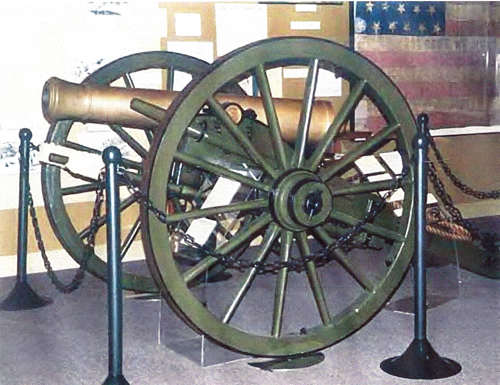
This gun was used by the 5th Battery Indiana Light Artillery in which Nelson Wesley Hall fought.
Following is documentation of monthly mustering roles for Nelson W. Hall from the time he enrolls 8 October 1861, mustered the following day by Lt. Col. Thomas Wood, until he is mustered out, 25 November 1864. As was true with thousands of soldiers during the Civil War, much time was spent fighting disease in hospital, primarily in Nashville, Tennessee, where his younger brother Erastus falls to illness and dies at war’s end. If you were to read these rolls carefully you’d see that throughout 1863 there is a duplication of registers, some of which log Nelson’s presence in the theatre and some which log his being in hospital–for the same months. Most likely we will never know the extent to which his illnesses kept him out of actual battle, but it’s clear he spent a lot of 1863 in a hospital or “in barracks” in Nashville. In October and November 1864 he’s sent instead to a hospital in Chattanooga for the first time, and in November 1864 he’s mustered out.
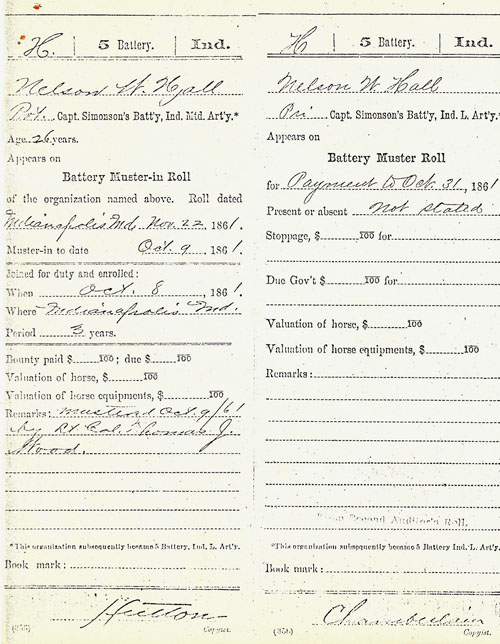
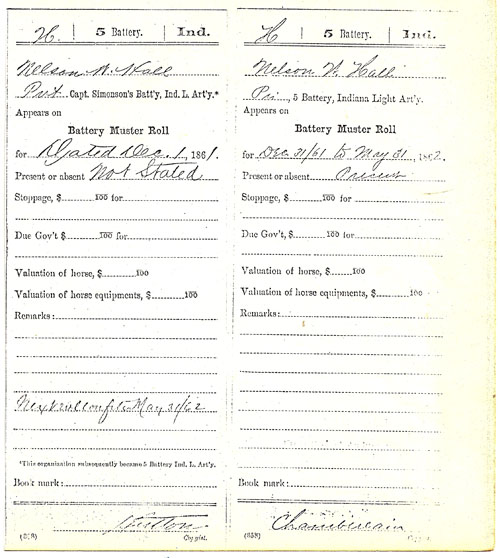
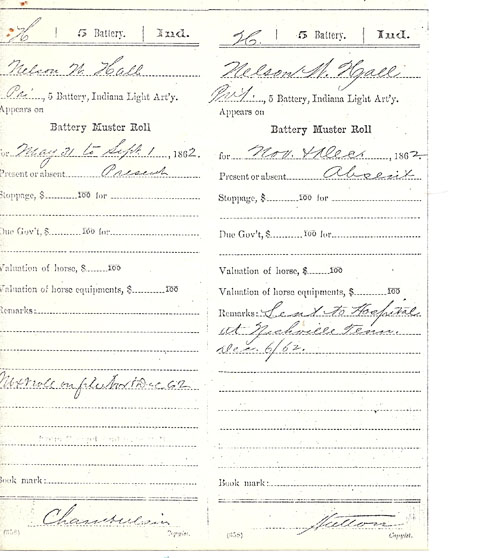
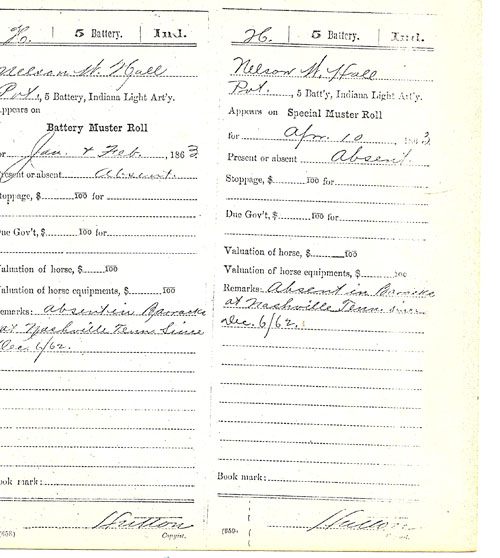
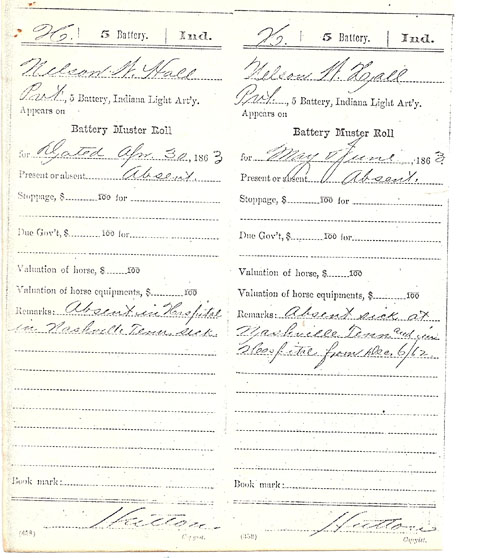
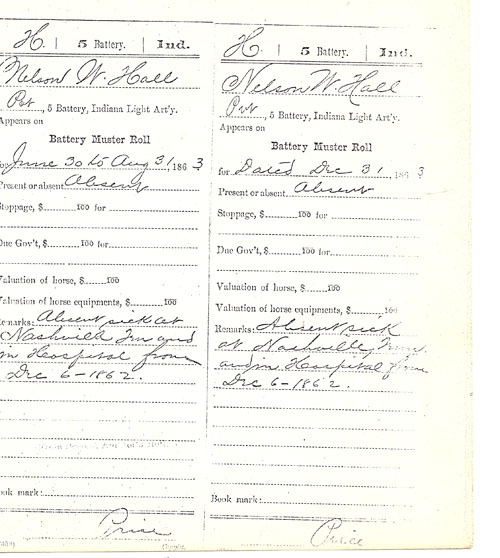
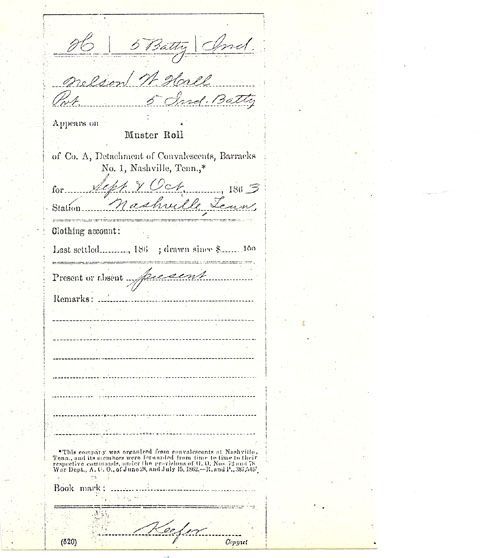
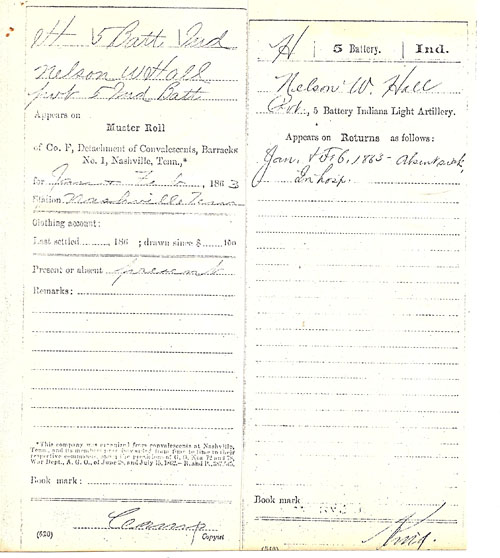
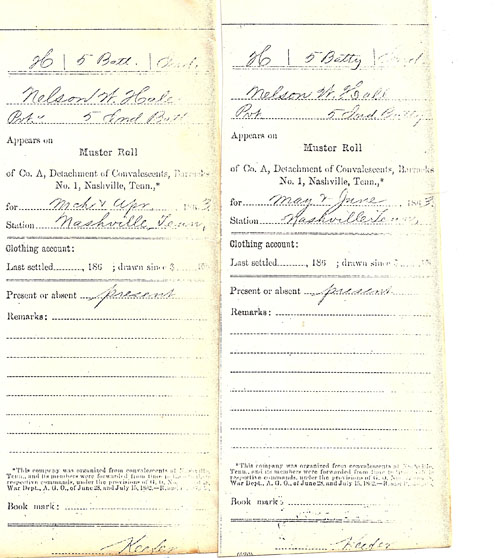
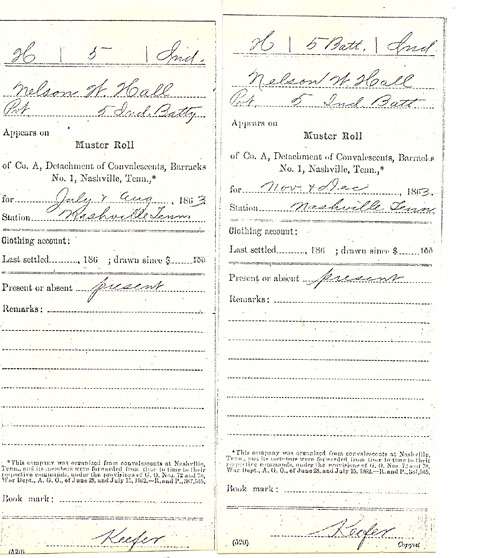

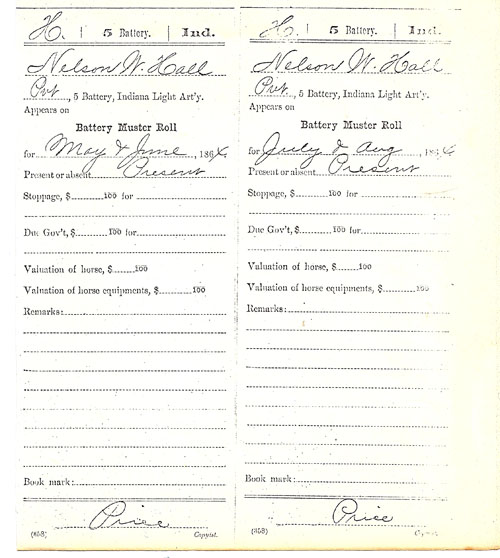
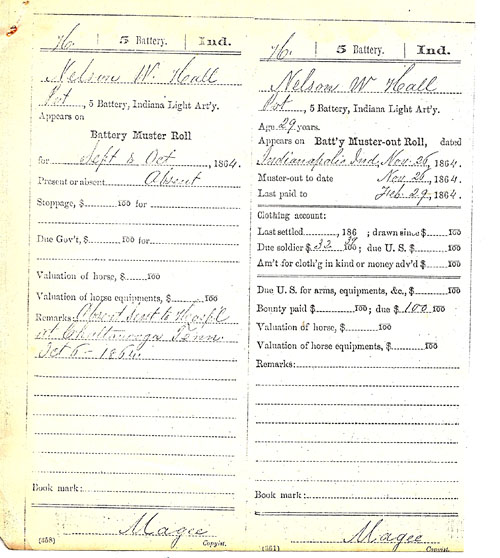
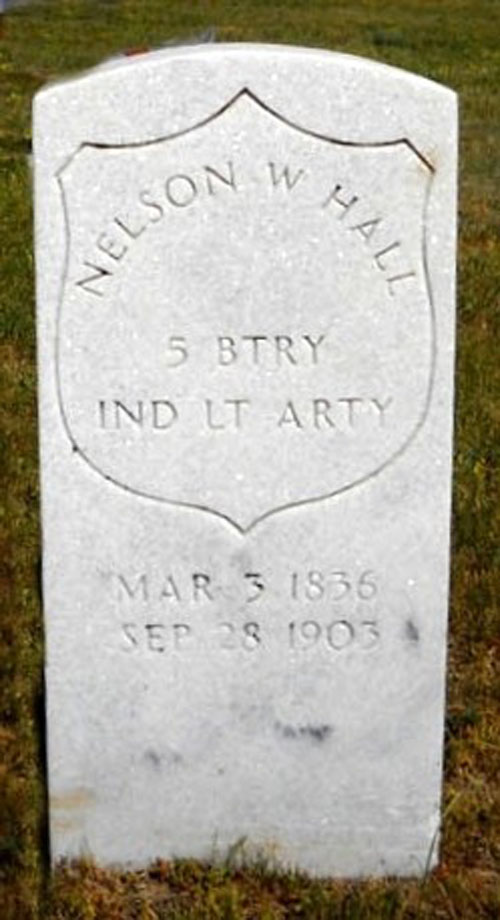
Gravestone of Nelson Wesley Hall, Gaylord, Otsego, Michigan
Editor’s note: This gravesite is currently in the process of being registered with the Sons of Union Veterans of the Civil War. When registration is complete it will be here posted. KH
Topics: Civil War | No Comments »
Death Certificate for Diantha Butler
By Kathryn Hall | November 2, 2012
November 2, 2012:
I am here posting the death certificate of Diantha Butler, daughter of Luke Hall and Mercy Steadman. To date this is the only written record I have unearthed verifying Mercy Steadman [Stedman], my brick wall.
Topics: Brick Wall: Mercy Stedman | No Comments »
Ancient Iron Works in Taunton (Part Two)
By Kathryn Hall | February 10, 2011
The following is a verbatim excerpt of “Ancient Iron Works in Taunton” by J.W.D. Hall in New England Historical and Genealogical Register [1884]. I have taken the liberty to capitalize all references to George Hall, our earliest known ancestor, as now proven through DNA results. (See posts on this blog for further information.) It is noteworthy to notice the role the two Leonard brothers played in the founding of the Ancient Iron Works of Taunton.
I ask that you please forgive slight discrepancies that came with the technology of reproducing from a pdf. Thank you.
KH
ANCIENT IRON WORKS IN TAUNTON
By J. W. D. Hall, of Taunton, Mass.
A HISTORY of the early iron enterprises in Massachusetts is not our purpose, as the subject has been exhausted in elaborate data and dissenting opinions, but rather to present a few interesting facts and incidents relative to the origin, progress and successful management of the ancient Iron Works of Taunton, derived from antiquarian researches and reliable records. Traditions, which do not bear the test of investigation, have crept into histories and census reports relative to the origin and management of these works; but let them pass.
It has been generally admitted that the first iron works enterprise in this state for the manufacture of bar iron from native ore was commenced on the banks of the Saugus River in Lynn, in 1643, by a company under the auspices and influence of John Winthrop, Jr., son of Gov. Winthrop, with an English capital from London of £1000, and skilled workmen imported for the purpose; that another iron enterprise was soon after started in ” Brantry ” by the same company, and that Boston donated 3000 acres of common land as an encouragement ” to set up iron works on the Monanticut River” in that town, where ore had been discovered. It is also alleged that an unexpected scarcity of ore and incompetent management in their infancy was followed by disaster to these enterprises, and that after spending a large amount, about £10,000, the company partially suspended operations in Lynn and Braintree, in the latter place in 1653 and in the former a few years later.
Iron ore had been discovered quite abundant in the flats bordering on Two Mile River and other localities in Taunton, and the enterprising Pilgrim settlers considered the field open for the establishment of a ” bloomerie ” on that river. It was also learned that Henry and James Leonard, skilled iron workers from Wales, who had been employed for several years at the works in Lynn and at Braintree by the Winthrop company, might be induced to come to Taunton and aid in the practical working of iron. Accordingly in October, 1652, preliminary steps were taken to establish the first iron works in the Old Colony, in Taunton, and the following was the record, Oct. 21, 1652 :
” It was at a town meeting conferred and agreed upon between the inhabitants of Taunton and Henry Leonard of Braintree :
Imprimis It was agreed and granted by the town to Henry and James Leonard, his brother, and Ralph Russell,Tree consent to come hither and join with certain of our inhabitants to set up a Bloomery Work on the Two Mile River.
” It was also agreed and granted by a free rote of the town, that such particular inhabitants as shall concur together with the said persons in this design, shall have free liberty from the town so to do, to build and set up this work, and that they shall have the woods on either side of the Two Mile River, wheresoever it is common on that side of the river, to cut for their cord wood to make coals, and also to dig and take moine or ore at Two Mile Meadow, or in any of the commons appertaining to the town, where it is not now in propriety.”*
In accordance with the above preliminary action, the leading citizens of Taunton interested in the enterprise, formed a stock company, inviting
[• Baylics’s Historical Memoir of the Colony of New Plymouth, Tart 11. p. 268.
Vol. Xxxviii. 24]
capitalists in other places to join them in carrying the project into effect without the aid of English capital—and they succeeded. To obtain the shareholders required some length of time; but the precise date when they were obtained has not been fully ascertained, nor is it known when the brothers Leonard and Mr. Russell came from Braintree. Probably it was soon after the suspension of the iron works there in 1653. Nor is there any record that Henry Leonard or Ralph Russell were employed in these works. They had land ” set off to them ” by the proprietors ” as encouragement,” but they did not remain to occupy it. Russell went to Dartmouth and soon after was engaged in starting iron works at ” Russell’s Mills.” Henry Leonard was at Lynn in 1655, says Newhall the historian, and some years later was engaged with his sons by a wealthy company of Salem in an iron works at Rowley Village. He afterwards went to New Jersey, and, it is said, successfully engaged with a company in the manufacture of bar iron. He has left in that state numerous descendants, among whom are men of ability and of prominent standing in business and the professions.
A documentary relic of the early date above referred to, recently found among ancient papers in the handwriting of Oliver Purchis, who was town clerk at the time, makes the following record preparatory to the organization of the Iron Works Company in 1653-4:
” The names of those who hath put in themselves to be proprietors in the Bloomerie, viz :—Hezekiah Hoare, Thomas Gilbert, Richard Will iains, Walter Dean, GEORGE HALL, Oliver Purchis, .(amen Walker, John Tisdall, Win. Parker, Mr. Gilbert sen’r: Peter Pitts, Richard Stacey, John Cobb, William Hodges, Nath’l Woodward, Timothy Holloway, James Burt, Edward Bobctt, Jonah Austin, sen’r, John Parker, Samuel Wilbore, Miss E Pole, Jane Pole.”
Additional records show the names of William Pole, Timothy Lindall of Salem, his son-in-law, Nicholas White, senr., Richard Stephens, John Turner, Thomas Lincoln, senr., Anthony Slocum, James Leonard, Tlios. Armsbe ry, Joseph Wilbore, Henry Andrews, JOHN HALL, James Phillips, Francis Smith, Geo. Watson, Gov. Leverett and Major Edward Tyng of Boston, Nath’l Paine, senr., and Stephen Paine of Rehoboth, John Cary and Nath’l Paine, Jr., of Bristol, Benedict Arnold of Newport, Richard Thayer of Braintree—contributing from £20 to £5 each, for whole, half and quarter shares.
The building of a suitable dam across ” Two Mile River,” where was previously a bridge ; preparing the timber for the necessary buildings; obtaining from abroad the hammers and heavy iron machinery and tools required for operating the ” bloomerie ” for the manufacture of bar iron, occupied a long time before the practical working of the same.
The following confirmatory record in a ledger of Capt. Thomas* Leonard, son of James,’ who was with his father a ” bloomer,” and became the ” clearke ” and manager in 1683, indicates the time the works commenced, as follows:
• This ledger was found in the old mansion built in 1750 by Dca. Elijah Leonard, grandson of Capt. Thomas,* who had carefully stored the books transmitted to him by his father and grandfather, when he built the house. It was the birthplace of Capt. Edward Leonard, who resided there seventy years, and of Rev. Elijah Leonard, of Marshfield, who died in February, 1834, after a forty-five years’ pastorate, and the father of Rev. Geo. Leonard, who died ill July, 1881, after a pastorate of thirty years in the same Marshfield church, and who inherited the old place in Raynham from his uncle, Capt. Edward. It was sold a few years ago to Mr. John Spinney, who in preparing to remodel the old mansion discovered the books deposited there one hundred and thirty years before. It was destroyed by fire shortly afterwards.
” An account of who hath been clerke of Taunton Iron Works ever since GEORGE HALL was first clerke, and some others joined with him for a time, which begun Anno 1656. Also, what product the works hath made from year to year.”
By this record, which has descended through two hundred years, and whose authority is undoubted, it is shown that the manufacture of iron was commenced ” Anno 1656.” On a page of this ledger are two columns of figures, indicating the years and the product of the works fifty-eight years, from that date, to the death of Capt. Thomas in 1713. The first line reads thus: ” 1656—George Hall clerke, John Turner working ye forge.” Three years no iron was shared. “1659,400 shared.” ” 1660, a ton of iron sold to buy goods, win: were divided.”
At this time an arrangement was made by the shareholders by which the works were leased to GEORGE HALL and his associates, Hezekiah Hoar and Francis Smith. The lease of this transaction, recently discovered among the papers of Capt. Thomas Leonard, thus sets forth iu substance the agreement:
” This present writing, dated April the first, anno domini, one thousand six hundred and sixtie. witnesseth : that whereas the Companie in partnership in the Iron works or bloomerie, erected and maintained in working use within the plantation of Taunton, in tho Colony of New Plymouth, did hy themselves and their attornies, generally consent and agree, that y« said works should he let for a term of five years; to begin after y° stock of coles is now being wrought out—yielding and paying to ye whole companie aforesaid, (not one partner at all excluded) yearly during said term the full sum of four ton of iron:”—” that said GEORGE HALL. Hezekiah Hoar and Francis Smith hnvins embraced, accepted, and received said tender, and rent of yc works, according to yc said propositions named.* themselves being partners “—and ” to whom full libertie was then and there given, that they might take into this contract with themselves whom they liked of.” Thev accordingly took into partnership : William Pole, Walter Deane. Joseph Wilhore, John Deane, Anthony Slocum, Thos. Linkon, senr. Wm. Parker, James Leonard, Jonah Austin sen’r. John Parker, Peter Pitts, James Phillips. Henry Withington. of Dorchester. ” The rest of said company in partnership, do by these present* ratify, confirm, establish, promise and make good and effectual to the s”d GEORGE HALL. Hezekiah Hoar, and Francis Smith, the said contract, and do hereby give them full power and right to act, or cause to be acted or done in and about said iron works in every particular case during yc said term without interruption, molestation or hindrance of y« partners, provided that thev truly and faithfully perform their engagements in the premises. . . . And the said partners, Win. Pole, Walter Denne and others, doe likewise covenant, promise and ensnge themselves, unto said GEORGE HALL, Hezekiah Hoarc nnd Francis Smith, to enrrie out said contract as one man, with faithfulness, according to their wisdom and abilities; that they will endeavor to prevent all damages and support each other in all cases, whether in charges of payments or troubles of lawsuits and walk together in kite and peace in the light of God, without superioritie one over another.”
” Tn witness whereof they herewith to one seal set their several hands the day and year above written :
Georqs Halt., IlraEKun Hoark, Francis Ssiim, [Seal.] Wm. Pole, Henry Withington, Jno. Deane, Wm. Parker, Walter Deane, Peter Pitts, Joseph Wilhore, James Phillips. John Parker, Anthony Slocum, Thos. Linkon sen., Jonah Austin.” ” In presence of
John Hatheway, Sam’l Linkon.
Resuming the old ledger records. GEORGE HALL held the position of manager and clerke thirteen years (excepting James Walker held the office a year) until his death in October, 1669, anil ” John Hull to y * end of y0 year.”
Drawn by James Walker, Richard Williams and John Tisdall, of said company.
« PreviousContinue »
“1670, Henry Andrews clerke.” “1671, John Hall, thence to 1675 when (says the record) the Indian [King Philip’s] War began and many coals burned in the woods.” ” 1676—the works garrisoned—great rates— many coals burned.” (No iron shared three years.) “1677, Israel Dean clerke. y” beginning, John Hall y° end of yc year.” Hall continued until 1683, and was succeeded by Capt. Thomas Leonard, during whose thirty years’ management occurred most of the transactions and ” orders ” recorded below in connection with this brief history of the most important enterprise in the early days of the Old Colony. He was an able, self-educated man ; he held military commissions from Ensign to Major in the Bristol County regiment; was the leading magistrate; presiding justice of the County Court, 1685 to 1693; clerk of the Taunton North Purchase proprietors, over twenty years ; filled various town offices ; also performed the duties of physician. He died in 1713, at the age of 70, leaving, besides a large estate, the Middleboro’ and Chartley Iron Works, a large quantity of official papers and miscellaneous relics, preserved with remarkable care during his eventful life.*
Dea. Samuel Leonard, in Oct. 1713, succeeded his father Capt. Thomas after many years of successful management. Another ancient ledger contains an instructive record of the transactions in the business during his charge; many pages are filled with items of the bar iron “circulating medium” and barter trades, similar to those appended. On the division of Taunton in 1731, the iron works locality fell to the new town of Raynham, and that town owned half a share. Dea. Leonard died in 1745, after thirty-two years’ service, owning several shares.
Dea. Samuel Leonard, Jr., was the successor of his father in the management of the iron works. He had, during his four years’ management, purchased a large number of whole and fractional shares, securing nearly a majority of the stock. He died in 1749, leaving a large incumbrance on the works and a declining stock. He left 12 shares, valued in his inventory at £C60 of the common currency.
Dea. Elijah Leonard, who had been at the ” Chartley Works ” in Norton, succeeded his brother in 1749, as clerk and manager. He soon afterwards built, a short distance east of the forge, the mansion referred to. He remained in charge of the business until 1777. During the last twenty years the shares had been depreciating in value, owing to the increasing price of coal, and the declining production of good ore, in competition with the New Jersey ore which contained a much larger percentage of pure iron, and was worked by competing establishments. With a depreciating currency and other obstacles, the iron business waned, the works hardly met expenses, the shareholders received trifling or no dividends, and the shares were relinquished at great sacrifice. The incumbrance on the works finally resulted in the sale of a large portion of the shares to Dea. George Leonard, brother of Dea. Elijah, who in 1770 disposed of them (7J sixteenths) to
• Tlic salary of Capt. Thomas was £8 the first year, and from 1684 to 1713 it was £11. His successor received tlic same amount. From 1742 to 1745, and thereafter, ” ten hundred of iron was voted for salary.” They also received a percentage on the iron manufactured. Tlic win ks made from 20 to 30 tons annually, which brought from £400 to £075, averaging about $100 a ton of our currency.
In 1749 £1 sterling, or “old tenor,” was worth £11 of Massachusetts currency. An oz. of silver, 0 shillings par value, stood at 66 shillings of that currency. Thus r.ipidly approaching ” flat money,” which was consummated by the United States national currency in pnying ofrthe soldiers of the revolution thirty years later, which became reduced to £1000 for £1 sterling, or about #1 per bushel.
Josiah Dean for £90—which shows a great reduction from the inventory value in 1749. At subsequent sales in 1777, tit low figures, of other shares, with a portion of the real estate, Mr. Dean became the purchaser. From the original shareholders the changes were numerous from year to year, and to attempt a record would require much time and space. Many of the sous, and descendants of the third generation from the original owners, held shares during the hundred years and more of the progress of the old iron works, until they passed into the hands of the new owner. The price of them varied from £22 to £20 the par value ; thence to £10, and finally, before the close, to £5 per share, or any price takers would give. Thus terminated the Leonard management, which had been conducted from 1(‘>8.’! by Capt. Thomas and by his son and grandsons nearly one hundred years, a large portion of the time upon the agency system, inaugurated in lU^G, as above described.
Having purchased a controlling interest in the ” old iron works,” lion. Josiah Dean took possession in 1777 ; he converted the bar iron forge, or ” bloomerie,” into a rolling mill and nail works, where also copper bolts were rolled and made for ship-building, &e. It was the first copper bolt manufactory in this region. After conducting the business about forty years he died in 1818.* He was succeeded by his son Major Kliab li. Dean, who in 1825 changed the nail works into an anchor forge, which was continued in that heavy line of iron manufacture by him and his son and successor, Theodore Dean, about forty years, when the works were suspended. About a year ago the old buildings were demolished, and the privilege, dam and foundation walls alone remain of the ancient Taunton Iron Works of two hundred and twenty-four years—the oldest successful iron manufactory in New England.
The pioneer settlers during a long period of the last and preceding century after the iron works were started, were seriously embarrassed in their increasing business transactions by the scarcity of money. They had but a small amount of specie, chiefly brought by emigrants who came across the ocean here to make their hoines. No banks had been established—no ” Land bank” capital had evoked even ” new tenor bills ;” no Bank of England or “old tenor” notes were in circulation, although the pioneers owed allegiance to ” His Majesty James ” the despot, and the edicts of his tyrannical subservient Sir Edmund Andros were borne until patience ceased to be a virtue. Therefore a dernier resort tr> bar iron, manufactured at the Taunton Works, as a “circulating medium of exchange,” to supply the great deficiency. Iron made from tlia native bog ore of the creeks and swails of Two Mile River, and ” Scaddiugs moire ” became more valuable than gold —an important factor in daily traffic it entered largely into the transactions of business, as is shown by the subjoined brief letters, orders and replies, couched in expressions of genuine old-time courtesy, from managers, shareholders and patrons of the ancient iron works. These amusing and interesting scraps were found between the leaves of Capt. Thomas Leonard’s ledger of two hundred years ago, the pages of which are tilled with the records of which these scraps were vouchers.
• Hon. Josiah Dean was a member of Congress in 1807-9, and town officer and magistrate for many years.
During the year 1652 a mint for coining silver money was established in Boston by the colony, and the first pine-tree shillings made from silver imported from the West Indies. This made but a small supply of specie.
Paper money was first issued In Massachusetts in 1690, but in very small quantity for the demand. The bank of England was established 1694. Vol. xxxvm. 24*
The veterans Deacons Richard Williams and “Walter Dean, Hezekiah Hoar, Shadrach Wilbore the second town clerk, Increase Robinson, Joseph Wilbore, James Walker, John Richmond, Peter Pitts, James Phillips, Richard Stephens, JOHN HALL, Peter Walker, and the sons of many successors of ownership of shares in the iron works, appear in the collection, also Rev. George Shove and Rev. Samuel Danforth, third and fourth ministers of Taunton ; John Pole, merchant of Boston, son of Capt. William and nephew of Elizabeth ; Benedict Arnold, son of Gov. Arnold of Newport, R. I. (who married a Taunton woman, daughter of John Turner) ; Nathaniel Paine and John Saffin of Bristol, Judges of Probate; and John Cary, Register; Dea. Samuel Topliff, Philip Withington and John Bird, selectmen of Dorchester nearly two hundred years ago; the polite John Baker, son of Richard ; Richard Thayer, son of the first settler and Mistress Dorothy of ” Brantry;” Peter Noyes of Sudbury, Capt. Thomas Leonard and his son Major George of Chartley Works, not to be outdone in ” loving phrase” by his father; and others. Schools were scarce in those primitive days, and many wealthy business men made their “mark;” therefore errors in orthography, unique expressions and ancient idioms may be excused. The first order is from one of the founders of Taunton and promoters of the iron works, who draws an order to pay a grocer’s bill:
” Ensignc Thou. Leonard, please to pay to Bar: Tipping nine shillings & three pence in iron, as money : from yr friend, Richard Williams.
Taunton 16: 1″ 1685-86.”
Deacon Walter Dean’s order.
” Ensign Thomas Leonard, Please to pay bearer hearof one hundred of Iron y« is due on Mr Shoves act. to my wife your friend.
Taunton y« 16 of y° 1st mo. 1685-6. Your friend, Walter Deans.”
” Thomas Leonard, clerke of the Iron Works of Taunton:
S’ pray pay to Joseph Crossman, on hundred of iron as money, & this shall be your discharge : this yc 13th Janurae, 1683. Hezekiau Boar.
Tanton— 84.”
A letter from some friendly parishioner in 1683, addressed to the third minister of Taunton, and accompanying order, reads thus :
“For the Rev. Mr. George Shove, pastor of the church of Christ in Taunton: These:”
” Ensign Leonard, pray deliver to John Hodgea or his order one hundred and half of iron on account of yr friend George Shots.
March 14, 83-4.”
John Gary of Bristol, Register of Probate, responds to a polite request to credit a hundred of iron:
” Loving friend, John Cary, these may inform you that if You please to Credit Richard Burt as much as comes to a hundred of Iron, I will be Responsible to you, & Rest your Lo» yr friend, Thomas Leonard.
Taunton Dec. 30, 1683-4.”
” lnsign Leonard, be pleased to pay to this bearer, James Tisdall, the assents of the above written bill, by which you will oblige Your friend, John Cart. January 2, 1684.”
An order from an early settler to pay the schoolmaster’s rate :
” Ensine Lenard, I pray you let Mr greene have four shillings more in iron, as money, and place it to my account. June 20, 1684. James Walker.”
” Capt. Leonard, pray pay to John Wetherel iron 9s. and 6d. and set it to my account. Samuel Wilbore.”
” Ensigne Leonard, pray deliver to Nath1 Coddington as much iron as comes to 4″ 5d at y” rate of 18s. per 0. John Deane.
Taunton Sept. 4,1685.”
He was son of John Dearie, senior, and the first birth among the pioneer settlers of Taunton.
Increase Robinson, one of the early settlers on Dean Street, gives a credit order for iron to pay his minister, Rev. Mr. Danforth :
” Captain Leonard : Sir, I would intreate you to pay James Tindole y° sum of 2-7-fi in iron at 82s. per hund. and make me Deptr for it on yc acount of y° Credit Air Danford save mie on your book. Your ffr’d Increase Robuinbon.
Tanton y° 23’1 March 1688-9.”
Thomas1 Williams (son of Richard1) sold an ox to one Nathaniel Smith, and the following orders ensued for payment:
” Nathaniel Smith, this is to desier you to pay to my Mother Williams three hundred & half a qur. of iron which is part of y* price of y° ox which you bought of mee. Thomas Williams.
Taunton yy 1G”1 of Oct. 1603.”
On the opposite side of the above Mr. Smith ordered the iron : ” Copt. Leonard, I pray be pleased to pay to old mother Williams 3 hundreth & half a quarter of Iron. Nathaniel Smith.”
Dorchester, May 15, lfiOC.
” Worh’ysrullSir:
After my service to your Honour, these are only to desire you to Send the income of my interest in the works by L’ Robinson and these shall bo the roocpt for the same. And if I could know when you come to Boston, I should lie willing to discourse w,h you in point of sale (it being at such a distance from me) if your self is inclined to buy. t remain y’ humble servant, John Bakes.”
Deacon Topliff orders iron for the half share due Dorchester :
” Caplin Li nurd—pray please to deliver to this bearer, Philip Withington, 800 and half of Iron, the which, by your information, is due to Dorchester: In so doing you will much oblige us your asurcd friends: Dated in Dorchester 8 Aug. 1699. Samuel Toi-liff.”
Capt. Leonard delivers 800 and half on the order for 1797- 98.
Taunton April I, 1700.
” Capt. Leonard I desire you to give John King credit upon works book for 20 shillings of iron as money. Your friend to serve JOHN HALL.”
An order from Rev. Samuel Danforth, the fourth minister of Taunton, to pay his *’ servant niayd ” :
11 To Captain Thomas Leonard,
Sr I would pray you to pay Elizabeth Gilbert (my late servant niayd) the sum of thirty shillings in iron at 18 sh. pr Cent: to her or her order—& place it to my account ••• pr yr friend and servant Sam” Danforth.”
Dated Tanton, March 11,1703-4.
Here is one of his business orders : Rev. Mr. Danforth wants iron to buy nails. ” To Capt. Thomas Leonard in Tanton:
Sr I have got Thomas Willis to go to Bridgewater to fetch me some nails from Mr. Mitchell’s this night: & pray to let him have 800 of iron to carry with him to pay for them : of winch, 100 on ace1 of Edward Richmond ; 5s. worth on acet. of Tliomas Linkon, son of John Linkon, by virtue of his note herewith sent you : for the remainder I may by yr leave be yr debtor for a while till I have another note from some other to ballance against it: & remain yr obliged Sam1 Danforth.”
Sfi 8″«>. 1708.
” Capt. Thomas Leonard:
S*—Give credit to William Briggs (son of Wm Briggs grand-sonior) & to Thomas Briggs his brother, for the sum of two shillings and (our pence in iron at 18 pr Cent, ft make me Debtor for the same in Yr book: This 2*hl” 41 is to pay thcyr iron part of thcyr Rate to the Ware bridge. Pr Sam” Danforth.”
Dated July 15, 1703.
” to be p4 to Increse Robbinson, Constable for the use aforesd.”
Order for iron “for the ministry of Dorchester.” ” Capt. Thomas Leonard of Taunton:— Sir : These lines may inform you y* the Selectmen of Dorchester, would desier you to deliver unto Surgt. Philip Withington all that iron, wh is due from the Iron Works to the ministry of Dorchester, and in so doting this shall be diecharg. Dorchester the 20 of March 1705. Samuel Capen, for the name and with the consent of the rest of the Selectmen.” Mr. Withington receipts for the product of the half share, 700 of iron for 1699, 1700, ‘1, i, and 3.
The genuine autographs of many of the early settlers are among these unique scraps of iron history, and are now in possession of the writer.
To illustrate the annual divisions of iron to shareholders, the following cases are cited from the old ledger records, from 1G83 to 1713, and later in Dea. Samuel’s records.
The oldest original shareholder was Richard Williams, who received in 1C83 for his one share £3 Gs.; for 1684-5, £4 8s. each year ; for 1G86 and 87, £3 Gs. each; for 1G88, £4 8s.; for 1089-00-91, £2 4s. each year, mostly in bar iron, or barter thereof at the stores of Bartholomew Tipping of Taunton, John Pole of Boston, Benedict Arnold of Newport, and other sources, butchers, shoemakers, weavers, &c, discounted at the iron works. Mr. Williams died in 1693, and his widow continued to receive the product share, through her son, who succeeded to his father’s business, tanning, from 1G91 to 1700 each year 2 C. to 4 ewt.; in 1701 2 C; 1702, £3 2s.; in 1703, £1 10s.; in 1704, £0 gs.; 1705, 13s 2d., about the same for five years ; in all 500 wt. of bar iron at 20s. per hundred ; discounting meeting bou.se, town, school master and county rates, and store pay, by tho clerk of the iron works, and occasionally a few shillings in mone}-. Dea. Williams was annually credited ” £2 10s. for a hide for the bellows.”
The town of Taunton held half a share, and to illustrate the amount others received, owning half shares,—in 1G83 £1 13s. was shared, or, “1 C. 2 qrs. in iron, ou Deacon Walter Dean’s order for the school master, Mr. Green;” for 1G84, “£2 4s. in iron, delivered on Dea. Dean’s order for same rate;” for 1685, £2 4s.; 1G8G, “£1 13s. paid by Dea. Dean for ammunition;” for 1687, £1 13s.; 1688, £2 4s. in iron; 1G89, £1 7s. 6d.; and 1G90, £1 2s. to Dea. Dean’s order to pay the meeting house rate of £2 15s. From that during the ten years to 1700, the average was £1 2s.; partially in money ordered by Dea. Dean for school and other rates, or in iron bartered. The amount of iron and money shared differed from the above in some cases, but iron was as much in demand as money, and as available in Boston and Dorchester as in Taunton.
The following illustrations from the ledger pages show the manner of conveyance of iron to shareholders in Boston, Dorchester and elsewhere. “June, 1685, delivered to Nicholas White, sen’r. to carry (through the wilderness) to Major E. Tyng, 7 C. of iron, also to Madam Leverett* of Boston 7 C. of iron; for Peter Noyes of Sudbury 5 C. 2 qrs. in bars, for John Baker of Dorchester 3 C. 2 qrs. and for Samuel Capen 3 C. 2 qrs. for Dorchester church, as their due for 1083-84.” “In November 1686, delivered to same to carry to Mrs. Tyng and Madam Leverett of Boston 4 C. and 12 lbs. each, for Mr Noyes of Sudbury 3 C. 2 qrs.; for Mr Baker 205 lbs. and for Mr Capen’s order 205 lbs. as their share for 1685.”
Thus, without long repetition of other cases, for twenty years or more, the annual transportation of iron (occasionally a little money) to shareholders, varied from year to year as the product of the iron works varied. The record, however, shows a gradual decline during the succeeding years.
• Widow of John Leverett, governor of Massachusetts 1673-79.
« PreviousContinue »
In 1700, delivered to Wm. Thomas of Plymouth 5 C. of iron for Madam Leverett; same amount for Mrs. Tyng of Boston, as their shares for two years, ” marked L, for John Pool of Boston.” ” To Philip Wellington per order of Selectmen of Dorchester, just 7 C. of iron for the four years, 1699 to 1703.” Also, ” per order Dea. Sam’l Topliff, for the Dorchester Church, 1 C. and half of iron for the years 1704, 5, 6 and 7, being £1 13s. each year.” “In 1720 & ’21, £1 2s.; in 1722 & ’23, nothing; from 1724 to 1732, 11 shillings each year, for Dorchester.” Other half shareholders same amount, or £1 2s. per share. Here ends the old ledger accounts, transferred to later books, of which whole columns are filled with the details.
Topics: Massachusetts | No Comments »
Ebenezer Hall and Matinicus Island
By Kathryn Hall | July 31, 2010
Dear Visitors: In honor of having recently connected through the miracle of DNA research with another cousin who is a descendant of the Halls of Maine I am dipping into my archives and posting this excerpt from Gems of the Ocean which relays an old version of the story of Ebenezer Hall of Matinicus Island. Note I said version. After reading this I encourage you to read notes from the non-profit organization Nedoba which documents the early history of the Abenaki People of Interior New England and their version of this story adds details omitted below. We might never know the actual details, but anyone searching the Halls of Maine invariably stumble upon Ebenezer Hall’s story in one form or another. If you have more (well researched) notes, please share below in comments section. Thank you! KH
Footnote: Here’s another link: http://tinyurl.com/2fs73g3
The following is an excerpt from Gems of the Ocean, Robert B. Fillmore (1914)
Very little has been written concerning the early history
of the island. The first records show that in 1728, William
Vaughn, one of the most prominent merchants of New England,
then residing at Damariscotta, came to Matinicus and established
a fishing station, employing several vessels. There are still
landmarks on the island, said to be the place where his build-
ings once stood, also the remains of an old wharf, the scene of
the early activities. These fishing stations were abandoned
and we can learn nothing more relating to the local history until
the year when Ebenezer Hall, the first settler, removed from
Portland to Matinicus. Following is the full account of his
massacre by the Indians, with genealogy of the family.
Early Mantinicus History
EBENEZER Hall lived at what is called the Back Cove, Port-
land, Me. There he raised three children, two daughters and
one son Ebenezer by name. The girls married. One wedded a
man by the name of Proctor, the other a man by the name of
Allen and moved back into the country in the town of Fal-
mouth.
Shortly after this the mother died and Mr. Hall married a
widow by the name of Green. She had three children, one
son by the name of Daniel and two daughters. The boy was 14
years of age and the girls 9 and 7. Mr Hall then with his family
moved to the Island of Matinicus, it being at the close of the
French and English war, at which time the English took the
Canadas and Nova Scotia from the French. He then built a
stone house which he could use as a fort for protection from the
Indians. The French, who were allied with the Indians, of-
fered a bounty for the scalp of every white man they killed,
whereupon a band of six Indians went to the Island and camped
about thirty feet south of the house between two granite ledges,
on a plat of grass about eight feet wide.
Then they besieged the dwelling. Mr Hall barred the door
to keep them out and was obliged to stay there nearly a week,
surrounded by them. In their determination to capture him
and his family, they sent fire arrows into the roof and burned
it. As fast as it took fire Mr. Hall would take a pole and push
off the burning rafters so they would not fall within the walls of
the house and at the same time his son shooting with a gun
whenever an opportunity offered. At last the ammunition of
the Indians was nearly exhausted and in their desire to lengthen
out their supply, they cut their lead bullets in two and as a decoy
one of the Indians, who had in his gun the last half bullet, went
up back of the house and took a position overlooking it and
prepared to discharge his gun at Mr. Hall whenever he should
show his head above the wall of the house. The other Indians
made what noise they could, walking over the pebbly shore and
hauling their canoe after them. Mr. Hall hearing the noise
that they were making and thinking that they had given up
their hope and were leaving the island, climbed up and looked
over the side of the house facing the shore, when the Indian
back of the house brought his gun to his shoulder and shot him
through the head and he fell back into the room dead. When
his wife realized that he was killed and she left without a pro-
tector, she screamed for quarter and the Indians hearing her,
rushed up from the beach and said “Your Sannah (being in-
terpreted husband) will not give any quarter.” She said ”my
husband is dead.” They immediately broke in the door and
proceeded to bind the mother and the two girls, removing the
scalp of Mr. Hall. The boy Daniel had escaped by the back
window and hidden in the woods back of the house in the under-
brush. The Indians took the mother and the two girls in their
canoes and after sinking one of the fishing boats that lay in the
harbor proceeded to Canada. The boy after remaining hidden
several hours and feeling satisfied that the Indians had given
up the hunt for him and had gone emerged from his hiding place
and looking around upon the situation, espied a fishing vessel
lying at anchor off in the bay. Finding half a canoe he paddled
off from the shore and when he had proceeded a proper distance
from the shore, he took his paddle and placing his coat upon it,
signalled to the vessel. Seeing him they came to his aid and
ascertaining his wants, came on shore and helped him bury his
father. He then returned to the schooner and sailed to the
Fox Islands, where the schooner belonged.
The evening previous to the final attack the Indians built
a fire just below the house and proceeded to get their supper.
They took some corn and pounded it in a mortar and then
cooked it. They then emptied it out of the kettle into a large
dish and seated themselves around it and with their spoons all
ate from the dish. Mr. Hall seeing them all busy eating, wanted
to take Daniel and three good guns they had loaded and creed
out of the back window to where he could get in range of them.
There he thought he could kill them all, but his wife in terror
seized him and would not let him go. At the first opportunity
Mrs. Hall made her escape from the Indians and returned to
the Island and later married in Boston. Her two daughters
were still held by the Indians but years afterwards were seen
with them in one of their visits to the island and being recognized
by their brother, he sought an interview, but they had become
so accustomed to the wild life of the forest they declined to take
but little notice of him. The next day he went to have a second
talk with them, hoping to induce them to return to civilized
life but it was of no avail.
In subsequent years Daniel took up and settled on what
is now known as Green Island, lying south of Carver’s Harbor.
He married a Miss Young of Old York, a sister of Susannah
Young of the same place. At the time of this murder and the
committing of these outrages by the Indians, Mr. Hall’s son
Ebenezer, was away fishing in one of his father’s boats
in the vicinity of Halifax, N. S. When he returned he found
his father was dead and the island forsaken. He then proceeded
to Boston with his fare of fish and on the passage up he put
into Old York for a harbor. There he formed the acquaintance
of Susannah Young, whom he afterwards married. They came
to Pemaquid and lived in the block house instead of returning
to Matinicus on account of the French and Indian war and the
hostilities against the whites. While there Mrs. Hall and
another woman while driving cows from the pasture were fol-
lowed by the Indians and barely escaped death from the bullets.
After peace was declared Mr. Hall and wife returned to
Matinicus and lived there many years and raised fifteen children
their names being: Hannah, born September 11, 1759; Mary,
born August 25, 1761; Susannah, born May 10, 1763; Jane, born
March 4, 1765; Ebenezer, born February 15, 1767; Margret,
born March 9, 1769; Patience, born February 14, 1771; Sally,
born February 9, 1773; Charity, born December 1, 1775; James,
born January 26, 1777; John, born December 25, 1778; Abigail,
born March 6, 1781; George, born May 3, 1783; David, born
January 30, 1786; Betsey, born May 30, 1788. Ebenezer Hall,
3d, born March 19, 1735, died February 14, 1813, buried on
Matinicus; Susannah Young Hall, his wife, born March 9,
1724, died December 9, 1831. After the death of her husband
she came to live with her son John Hall and is buried in the old
cemetery at the ”Head of the Bay” South Thomaston.
Capt. Hiram Hall is the owner of an iron kettle that was
left on Matinicus in 1757 by his great great grandfather Ebene-
zer Hall, who was killed by the Indians.
Ebenezer Hall, 3d, died February 14, 1814, age 78 years,
11 months, 9 days. His father Ebenezer, 2d, was killed by the
Indians on Matinicus in 1757. His wife, Mrs. Hall, a lady of
remarkable beauty and many accomplishments, was captured
with her two daughters, after her husband had been killed. They
were carried to Canada, where they were separated. Mrs. Hall
was eventually ransomed. But this unhappy woman, notwith-
standing her life long endeavors, could never obtain the least
knowledge of her children or their fate. The father of the above
Ebenezer was probably one of three brothers that came from
England. He was a lieutenant in the English army and was
present in the battle of Mines at the siege of Louisburg and was
wounded and died at Annapolis, Nova Scotia.
The above was taken from Abbott’s History of Maine. [Editor’s note: The History of Maine by John Stevens Cabot Abbott]
When Ebenezer Hall lived on Matinicus, a great many
years ago, there lived in the family a girl by the name of Dorcas
Young, a sister to Hall’s wife. Joseph Greene was paying his
addresses to Dorcas at the time. One night Hall invited some
fishermen up to the house, so he said to Greene, “Joe, don’t you
and Dorcas want to get married?” “I don’t know,” says Joe.
He started for the cow yard where Dorcas was milking the cows,
and asked her if she thought they had better get married, that
night. “Why Joe,” says Dorcas, “I have not got any wed-
ding gown.” “Never mind the gown,” says Joe, so they went
into the house, Dorcas washed herself, put on a clean apron,
stood up, and they were married, there being a justice of the
peace among the crowd.
The descendants of Ebenezer Hall, who was killed by the
Indians, formed a reunion association in 1906 and have raised
money and purchased a bronze tablet, which will be set in the
rock at or near the spot where Mr. Hall was killed, near what
is now Henry Young and Company’s store. The stone which
formed the base of the chimney of Hall’s house is located in
front of the store and the ledge behind which the Indians were
concealed is but a few yards distant.
The tablet bears the following inscription:
”Ebenezer Hall. The first white settler on Matinicus Isle,
Maine, killed by the Indians, June 6, 1757.”
Topics: Book Corner | 6 Comments »
DNA Match of Ichabod Hall to George Hall of Taunton
By Kathryn Hall | June 5, 2010
Editor’s note: The 67 marker DNA results for a descendant of Ichabod Hall are now in. This is excellent news for all researchers who believe they might be a descendant of this family. Here’s the DNA panel you will want to consult:
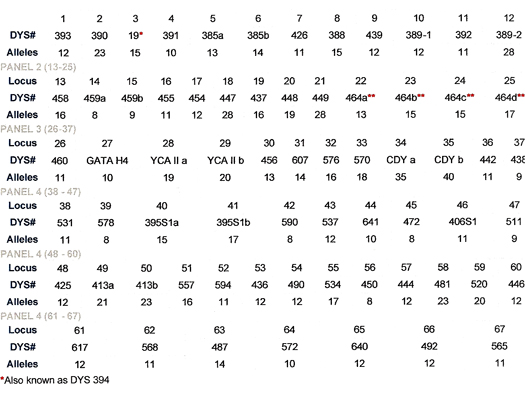
Most importantly this DNA panel reveals a match between a descendant of Ichabod Hall of Enfield and two proven descendants of George Hall of Taunton. Here are the DNA results of one of the descendants of George Hall and of Ichabod Hall.
And these results can be compared to previous DNA test results posted for my father and the same descendant of George Hall (an exact match).
Note that in the DNA test results for Ichabod and the George Hall descendant, there are four mutations, in the following markers: DYS439, DYS449, DYS570, CDY b. Each of these markers is where one would most expect mutations to appear, i.e, these fast-moving markers are where change/mutations ordinarily are found over time. This is an excellent and important discovery that undoes many errors and wrong speculations from the past, and that places Ichabod and his descendants correctly with the George Hall of Taunton family.
Ancestry of Ichabod Hall (—d. 1787) of Somers and Enfield, CT
In 1846, R.R. Hinman published his Catalogue of the First Puritan Settlers of the Colony of Connecticut (Hartford, E..E. Gleason). In the section “List of First Settlers who have few or no Descendents in Enfield” Hinman describes “Hall, Ichabod, Nicholas and John- three brothers who were early settlers in the east part of Enfield…Ichabod settled on the Somers Road, had three sons, Ebenezer, b. 1730, went to Tyringham, Moses, b. 1732, Elisha, b.1751.” (p. 178). Hinman makes no mention of the parentage of the three brothers. Samuel Hall is not mentioned in the work, nor does Hinman give a source for linking the three brothers.
In 1883, David B. Hall published The Halls of New England and used Hinman as a source to place Ichabod as a child of Samuel Hall and Elizabeth Bourne.(p 696) Because he placed Samuel and Elizabeth in the family of Edward Hall of Rehoboth, he guaranteed confusion for future researchers.
In 1929, James Kibbe published his manuscript which stated that because Ichabod did not appear in the list of children born to Samuel and Elizabeth in Taunton MA,, he was probably not of that family. There was no evidence linking Ichabod to Edward Hall, either, once the wives and Samuels were disentangled.
In fact, to date no records have yet been found to link Ichabod of Somers to any other Hall families in the areas of Taunton, MA, or Suffield, Somers or Enfield. – no vital records, probate documents or land records. A land record in Enfield, CT, dated March 5, 1765, records Ichabod Hall selling a parcel of land to Samuel Hall of Somers, but no familial connection is noted.
Ichabod Hall’s link to Samuel and thus to George Hall has consisted of the unsourced comment of Hinman, who merely links Ichabod to Nicholas and John, both of whom were proven sons of Samuel. That is, until now.
In May, 2010, Family Tree DNA test results revealed a match between Ichabod and two of a proven descendants of George Hall of Taunton. The Ichabod descendant is an eighth generation grandson of Ichabod, with a solid paper trail consisting of vital records, probate documents, Bible entries, obituaries, family letters and published genealogies.
The results showed a close match to the proven tester descended from George Hall of Taunton. There are 4 markers with a one point difference in markers 1 through 37. These markers are the ones where mutations are likely to occur. For markers 38 through 67, the stable, unchanging range, the match is perfect.
The matching testers for George are descendents of Samuel. In addition, Samuel was the only one of George’s descendents to emigrate to the Somers-Enfield area, where Ichabod lived. The test results and the close proximity of Ichabod to Samuel’s family allow us to know that Ichabod was indeed a son of Samuel and Elizabeth.EGL & MHB, descendents of Ichabod Hall of Enfield
Topics: Regarding DNA | No Comments »
Ichabod Hall of Enfield, CT
By Kathryn Hall | March 25, 2010
The following guest post written by two descendants of Ichabod Hall clarifies, corrects and expands the notes we find in The Kibbe Manuscript on Halls of Taunton. My deepest gratitude is here expressed to these fine researchers in sharing their well documented family history. ~KH
Although the ancestry of Ichabod Hall of Enfield, CT is uncertain, his life from the time of his marriage to Lois Kibbe until his death is documented. He is mentioned numerous times in all three volumes of History of Enfield: Compiled from all the public records known to exist, covering from the beginning to 1850, by Francis Allen Olcott; Lancaster, PA; Wickerson Printing Co., 1901. Most of the information that follows is taken from that work, with the exception of two land records and a few vital records, which are noted separately. Spellings from the original documents were repeated in Allen’s work, and are thus repeated here.
The earliest record for Ichabod Hall in Enfield, CT is an intention of marriage published May 31, 1730, for Ichabod Hall and Lois Kibbe (Allen, Vol. 2, “Intentions of Marriages” p.1756). The marriage itself took place June 25, 1730 (Allen, Vol. 2, “Marriages”, p. 1770; Vital Records of Enfield, CT., Town Book 1, 1682-1789, p. 52).
Ichabod and Lois had 10 children between the years of 1730 and 1751: Ebenezer, b. Nov. 9, 1730, (Allen, Vol. 2, Births, p. 1629 and Town Book 1, p. 37); Moses, b. Oct. 8, 1732; Lois, b. Mar. 10, 1735/6; Hannah, b. Mar. 10, 1736/7, Elizabeth, b. Mar. 15, 1738/9; Eunice, a twin, the other child, male, stillborn, Mar. 26, 1741; Miriam, b. Apr. 4, 1745; Mary, b. Sept.23, 1748 (Allen, p. 1629) Elisha, b. Nov. 22, 1751 (Allen, p. 1629 and Town Book, 1, 1682-1789, p.83).
Elisha’s birth year has been given as both 1751 (R.R. Hinman, Catalogue of the Names of the First Puritan Settlers of the Colony of CT, printed by E. Gleason, Hartford, 1846, p. 178) and 1761 (Allen, p. 1629). A certified copy of the record, made May 22, 2009 from the vital record above, has a note that the birth year is not discernable, and has attached a photocopy of the original record. The year could be either 1751 or 1761. To clarify that the year is 1751, it is necessary to look at the record of births for Elisha’s children (the eldest, Samuel, b. Apr. 22, 1773, New Marlborough, MA, Births, 1734-1858, vol. 1,p. 24) and his own death record, May 6, 1842, age 91, (New Marlborough, MA, Old Records, Book 2nd, Births and Deaths, 1797, p.10).
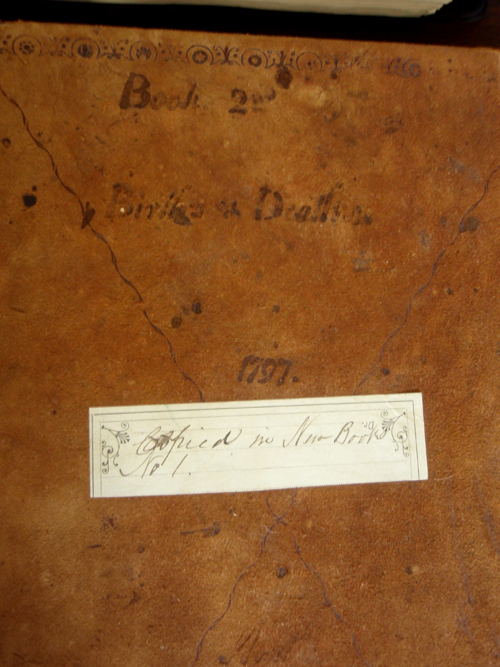
While Ichabod was raising his large family, he was also active in the town. He was chosen to serve as one of the Hog Reeves for the years 1731 (Allen, Vol. 1, Town Meetings, p. 359), 1735 (pp. 371-372) and 1737 (pp. 378-379).
On December 18th, 1744, a vote at Town Meeting freed Ichabod Hall “of his town & minister Rates for this Present year—” (Allen, p. 401). No reason is given.
Ichabod is known to have owned property as early as 1733. In Vol. 1, “Land Grants”, pp. 230-231, a parcel of land is described as, “laid out to the Estate of Deacon Isaac Pease, late Decsd…Bounded….west on Ichabod Hall’s Land, entered May 15th, 1733…” Ichabod is mentioned again, on p. 277: “hath laide out 25 acres of land lying at Brook meadow…Entered March 22nd, 1737”. In Volume1, “Commoners Book A”, on Oct. 2, 1754, a parcel of land is “Surveyed and Laid out to Ichabod Hall, twelve acres and one quarter of land in Somers…” (Allen, p.775). Ichabod is also listed in “A Table of Common Rights” on page 776. Three more parcels, laid out in January, 1757 are described in the Commoners Book, on pp. 868, 869 and 891. The parcels of land are in Somers, one for nine acres, one for thirty acres and one for twenty, respectively.
Ichabod is named twice in Volume 3, “Town Records”. On p. 2483, it is noted that on “June 26, 1753, Ichabod hall Entered his mark which is a Crop off of the Left Ear and two half pennys the und Side of the Same Ear.” A few pages later, under “Estrays, Etc.”, it is noted: “Taken up By Ichabod hall November 3rd 1761 a Red white faced heifer year old past marked with a Crop in the near Ear and a slit in the Crop.” (Allen, p. 2499).
In Volume 3, “Enfield and Somers Soldiers in the Colonial Wars” Ichabod mustered into the 1st Regiment, 9th Co., April 16, 1759. “That year’s Expedition was engaged in the reduction of Fort Louis at Oswego and the capture of Montreal.” (Allen, p.2640) Ichabod served again in the same regiment and company from March 25-Nov.25, 1760. “This year’s expedition was engaged in the reduction of Canada.” (Allen, pp. 2640-2641).
Ichabod is mentioned several times in Vol. 2 ,“Treasurer’s Book”. This is described as the “Enfield Book for Town Accounts to be keept (sic) in Feby. 22, 1714/15. From 1741 to 1805.” (p.913). The first entry for Ichabod, on p. 913, is undated, but is just prior to entries dated 1743/44. The entry is the third one in a series, and reads “by Ichabod Hall 0-18-11”. This amount is part of a final tally a few entries later. Other entries for Ichabod are: Nov. 8th, 1751, “Paid Ichabod Hall per order 08-05-02”; (p. 936), December 12th, 1752, “By Crossing Ichabod halls Rate in part, 1-12-00”; (p.937); Sept. 6th, 1761, “order to pay Ichabod Hall 0-02-01” (p.950); March 24, 1763, “by an order returned on which you paid Ichabod Hall 00-02-01” (p. 950). An additional entry on p. 986 , dated Sept. 6th, 1762 is “to order to pay Ichabod Hall 00-02-01.” The reason for the payment is not given.
The last pertinent records for Ichabod Hall in Enfield are for the sale of two parcels of land. A record dated February 24, 1764, states that Ichabod is of Hartford County (Land Records of Enfield, CT, 1760-1773, Book 3, pp. 155-156.) In a subsequent sale, dated March 5, 1765, Ichabod is recorded as” being in the county of Berkshire, in the colony of Massachusetts Bay” (Land Records of Enfield CT, 1760-1773, Book 3, p. 248.) The land sold in 1765 was purchased by Samuel Hall of Somers.
It appears from an examination of the original records that Ichabod was illiterate. His name is recorded in both documents in the handwriting of the clerk; beside Ichabod’s name is a circle, with the word “Seal” inside.
Ichabod and Lois moved to New Marlborough, MA, after their son Ebenezer Hall, Sr. and his wife Anna Pease Hall settled there. Ebenezer and Anna married in Enfield, CT. May 27, 1753 (Enfield Town Book, 1, 1682-1789, p. 198) and were in New Marlborough by 1760, when their daughter Susannah was born July 19. (Record of Marriages, Births and Deaths in New Marlborough, MA, by Otis Lombard, 1860, p. 268.)
Land records of New Marlborough may indicate that at least one daughter, Lois, married to Daniel Winchell of Suffield, had also moved to New Marlborough prior to Ichabod and Lois, but further research is needed to verify this. A search of these records would also yield further information on Ichabod and Ebenezer.
The deaths of Ichabod Hall and Lois (Kibbe) Hall are recorded in the vital records of New Marlborough, MA. Ichabod died February 4, 1787; Lois died November 6th, 1796. (Old Records, Book 2nd, Births and Deaths, 1797, p.10). Their burial places are unknown.
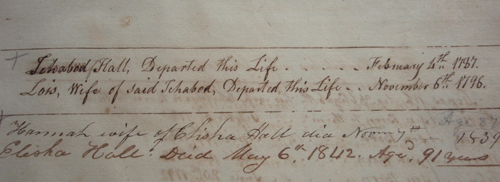
~EGL & MHB, Descendents of Ichabod Hall of Enfield, CT.
Topics: Guest Posts | 4 Comments »
« Previous Entries Next Entries »


